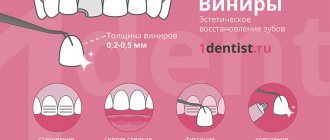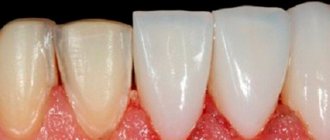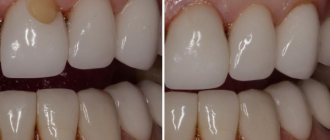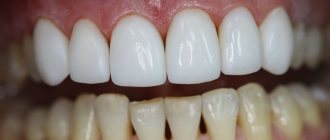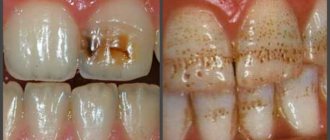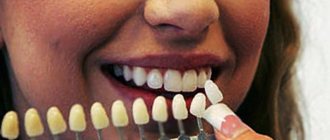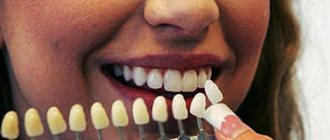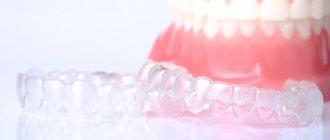People who want to have straight, beautiful teeth often wonder which dental structure to choose. Veneers or braces - which is better? In this article we will talk about the main differences between braces and veneers. Which option is best for you?
In this article
- What is the difference between veneers and braces?
- When can veneers be placed?
- When are braces better than veneers?
- What is the difference between veneers and braces?
- Veneers or braces - which is better?
- Is it possible to put braces on veneers?
- Conclusion
What is the difference between veneers and braces?
To understand the differences between braces and veneers, you need to take a closer look at their design. Braces are an orthodontic device that is aimed at correcting malocclusion and uneven teeth. It consists of small clasps that are fixed on the teeth according to a pre-designed pattern, and also a metal arch with shape memory. When an orthodontist places braces on crooked teeth or a jaw with a malocclusion, the pressure from the archwire begins to move the teeth into the correct position. This process is slow and can take from a year to 3 or more years. The duration of treatment will depend on the complexity of the pathology, the age of the patient and a number of other factors.
Veneers are a fundamentally different design. They can be compared to false artificial nails, which are imperfect real ones underneath. Only veneers are plates that imitate the shape and color of real teeth and look very natural. With the help of veneers, you can disguise chips, curvatures and other imperfections.
To understand whether to install veneers or braces, which is best for you, you need to understand what result you expect. And to do this, evaluate the indications for the installation of one or another dental structure.
Laminates for teeth
Straight overlays are called "laminates". They are made from a composite light-curing material in the patient's mouth. Before installing the laminate, the tooth is prepared and ground. In this case, its surface is covered with several layers of composite. If the patient does not want the top enamel layer to be removed from the surface of his tooth, then the doctor uses opaque shades of the composite material, which are called “opaque.” However, the use of such a composite can create the effect of false nails, which is noticeable to a prying eye. The fact is that the teeth will turn out to be bulging, unaesthetic and unnatural. The service life of laminates depends on the quality of oral hygiene and the degree of chewing load. The patient's addiction to alcoholic beverages significantly reduces the strength of composite veneers. Porcelain veneers are stronger, more durable, and more durable. They are made in laboratory conditions and are famous for their amazing aesthetics, stability of shade and configuration, as well as long service life.
When can veneers be placed?
Main indications for their installation:
- chipped teeth;
- non-carious pathologies that spoil the appearance of teeth (fluorosis, hypo- or hyperplasia);
- large gap between the front teeth;
- persistent darkening of tooth enamel;
- unsightly fillings that stand out against the background of the teeth and spoil the smile;
- wedge-shaped defect.
That is, the main purpose of veneers is cosmetic correction of the smile area. With their help, you can hide aesthetic imperfections in just a few procedures. It is important to understand that veneers are attached to the teeth as a “veneer” and simply mask the defect. They will not be able to correct abnormal bites, uneven teeth and other orthodontic disorders.
Can crooked teeth be corrected with veneers?
Crowding of units, interdental gaps, curvature - all these are factors that act as medical indications for orthodontic treatment. However, in situations where the severity of the defect is insignificant, artificial crowns or veneers may be a solution to the problem.
Thin ceramic plates installed on the vestibular surface of the frontal elements form an even and aesthetically attractive row. Veneers can hide small trema and diastemas, correct minor curvatures, and also improve the shade of tooth enamel that has undergone pigmentation. The material for manufacturing can be not only ceramics, but also composite compounds - in this case, the cost of treatment will be lower, however, the characteristics of the products will differ.
When are braces better than veneers?
There are other indications for wearing braces:
- Malocclusion (distal, open, mesial, deep, crossbite).
- Unevenly spaced teeth or entire rows of teeth.
- Impacted (unerupted teeth) when they need to be brought to the surface.
- Preparation for implant installation, prosthetics.
- Correction of jaw shape and facial profile.
It is clear that braces do not mask the problem, but radically solve it. They change the position of the teeth and the shape of the jaw, thereby eliminating the root cause of orthodontic problems.
Indications for installing braces
Orthodontists use braces to solve the following problems:
- Crowded teeth.
- Gaps between teeth.
- Abnormal bite.
- Single defects in the dentition are unfolded or tilted teeth.
- Pathologies in jaw development.
PROMOTION
Wisdom tooth removal
4,000 rub.
What is the difference between veneers and braces?
These dental structures differ not only in design and functionality. They have many differences in other parameters.
- Material.
Braces can be made of metal, ceramics, sapphire, and plastic. Veneers are made from composite and ceramic materials, ceramic composite, and zirconium dioxide.
- Fixation zone.
The bracket system can be installed both on the outside and on the inside of the teeth. Lately, lingual braces (internal braces), which are invisible to others, have become popular. Veneers “mask the facade”, so they are always placed only on the outside of the teeth.
- The need for turning.
To install braces, you do not need to grind your teeth. After removal of the structure, the teeth will remain in their original condition if the patient properly cares for them during orthodontic treatment. To install veneers, you need to grind the tooth by 0.3-1 mm. This process is irreversible. If a person once wants to remove the overlays, the enamel will no longer return to its original appearance.
- Anesthesia during installation.
To install veneers, the tooth must be ground down quite heavily, so in most cases anesthesia is required. The process of installing the bracket system is painless, although the patient may experience slight discomfort when fixing the arch in the clasps. No anesthesia is required to install braces.
- Discomfort after installation.
Veneers do not cause feelings of pressure or pain after the installation procedure. This is due to the fact that, unlike braces, they do not apply force to the teeth, but only hide imperfections. After installation of veneers, the patient almost never feels pain. After installing braces - quite often. The stronger the malocclusion, the more pronounced the pain will be. The most severe discomfort will be in the first week after installation.
- Aesthetics.
In matters of beauty, braces, of course, are inferior to veneers. Even the most aesthetic and transparent sapphire braces are still visible to one degree or another on the teeth. In addition, they cannot hide crooked teeth or malocclusion. Veneers look beautiful and mask natural imperfections in the dentition.
- Doctor visits.
The entire cycle from the first visit to the doctor to the actual installation of veneers takes approximately 2-3 days, after which the patient is recommended to come for a scheduled appointment for examination once a year. A person with braces will have to visit the dentist more often. Depending on the type of brace system - once every 3-8 weeks. This is necessary for the specialist to adjust the traction force and monitor the effectiveness of treatment over time.
- Recovery period.
Correction with veneers does not involve a recovery period. After treatment with braces, you will have to wear special retention aligners for several more months, which allow you to maintain the achieved result, fix the teeth in the correct position, and prevent them from moving back.
- Specifics of care.
Onlays are much easier to care for because they are smooth, mimic natural teeth, and require proper care. Braces make oral hygiene significantly more difficult. To care for them, a toothbrush is usually not enough; special devices are required - brushes, single-beam, V-shaped brushes, super-flosses, irrigators. Without an integrated approach, it is impossible to achieve high-quality cleaning, which is fraught with the development of caries and other dental problems.
We start with the upper front teeth
On the upper front teeth, all the composite and all the material from the teeth were almost completely removed. On the fours and fives on top we only had roots. The front teeth were also not distinguished by the presence of large tissues; we also only had roots. Except for tooth 2.2, tooth 2.2 was alive. That is, of the top 10 teeth with which we worked, only 3 teeth were alive, and 7 were previously depulped.
It turns out we had 4 chewing teeth of which only the root remained, and all the composite fillings were removed from the 3 front teeth; they went almost to the root.
We slightly drilled the root canal
in order to install single-module veneers with the root part.
See what veneers look like with the root
:
Features of treating crooked teeth for veneers in the lower jaw
By the time the lower teeth were turned, we had already prepared a project, which I relied on - we displayed it on a huge 43-inch monitor. We did something incredible. Taking into account gum correction (the gum was corrected at tooth 1.1)
Below was a very complex project. After we sharpened we received photographs and a real view of the lower teeth
:
Once trimmed, it looked incredible. It felt like the teeth were completely straight from the start.
Despite the fact that the lower teeth were actually very crooked, we were able to build the ideal geometry of the dentition. Some teeth, such as 3.1, we “pushed” inward a little, and then did the same with teeth 4.1, 4.3 and 3.3.
We filed down the central lower teeth very much from the inside ( BUT!
We didn’t reach the nerve). We “moved” teeth 3.2 and 4.2 outward, filing down their inner part. As a result, as I said earlier, we did not depulpate a single tooth.
The teeth from below, from fang to fang, look quite even, that is, we managed to reach an even plane, an even line. Since we ground teeth 3.2 and 4.2 both inside and out, we decided to make practically crowns on them, that is, the contact points between the teeth remained intact, and the front and back parts were ground as if for a crown.
Is it possible to put braces on veneers?
Sometimes there are situations when a person wants to correct his bite using a braces system, but he already has veneers installed on his teeth. And then the question arises: is it possible or not to install an orthodontic device on top of veneers?
Dentists note that the presence of veneers is not a contraindication to installing braces. But the patient must be prepared for the fact that the braces will often come off the surface of the veneers, and this directly affects the effectiveness of orthodontic treatment. In addition, the onlays are quite fragile and can break under pressure, and when the teeth in the jaw shift, the position of the onlays will change and they will no longer hold on.
If a patient has veneers, a good orthodontist will not recommend treatment with braces, but will suggest an alternative way to correct the bite.
Advantages and disadvantages of veneers
Correction using ceramic onlays takes no more than 2-3 weeks. To become the owner of straight teeth and a luxurious smile, the patient only needs to visit the dental clinic 1-2 times.
Veneers do not require special care, the adaptation process is quick, which is also an advantage.
Now about the disadvantages. To install the onlays, the teeth will have to be ground down. The service life of veneers is about 10 years, after which they will have to be removed and reinstalled.
Veneering is not suitable for straightening lateral teeth, and its cost is higher than the price of braces.
Stages of work on smile aesthetics
The work was carried out in two stages. First we did the top
.
First, we took impressions and made a photographic record. After 5 days, we trimmed the upper teeth and installed temporary veneers
.
After another 6 days, we installed veneers on the upper teeth, during the same appointment we ground down the lower teeth and placed temporary veneers on the lower teeth
.
At the 4th appointment we already fixed the veneers on the lower jaw.
The color of our veneers was OM3
. We chose the color for a very long time and carefully.
It turned out to be a really beautiful color, perfectly matching Maria’s wishes.
Maria became completely different after we fixed the bottom.
We got a fairly serious, smooth job.
Nothing hurts, nothing crunches, nothing bothers her, that is, the joint does not bother her at all. Everything worked out perfectly for our gums.
For the first few days, she took painkillers because her teeth had been sharpened quite seriously.
Contraindications for installation
Veneers instead of braces are good if you only need to solve the aesthetic side of the issue, but installing them in case of severe bite pathologies leading to uneven load when chewing is impossible, because In this case, restorations cannot be made as aesthetically pleasing as possible; moreover, they will not last long, and will not solve health problems or correct functional disorders in the functioning of the maxillofacial apparatus.
Otherwise, the contraindications for installing both structures are similar:
- absence of a large number of teeth: however, orthodontic appliances can be installed in the absence of some units (for example, sixes and sevens),
- presence of prostheses and implants,
- gingivitis, periodontitis and periodontal disease,
- extensive caries,
- early age of the patient: braces cannot be installed until the final change of the primary bite to a permanent one occurs (i.e., not earlier than 14-16 years). Dentures cannot be placed until the enamel is completely formed and mineralized,
- decayed teeth,
- bruxism,
- mental disorders.
Which designs are still better to give preference to?
Veneers or braces: which is better? It is impossible to answer this question unambiguously, because... the designs have too many differences to compare them with each other. Moreover, reviews from experts suggest that it would not be entirely correct to make comparisons here, because the goals of the structures are the same, but the tasks are completely different. Braces “work” on a large scale and ultimately help solve not only aesthetic problems, but also health problems (headaches, gastrointestinal disorders, impaired diction and articulation, the risk of developing dental diseases). With the help of veneers, you can change your smile quickly and with minimal discomfort1, but they act only locally and are suitable when the defects do not cause any inconvenience other than aesthetic ones.
Patients often think that it is better to get veneers, because... it’s faster, more beautiful and cheaper, but you have to wear braces for a long time, and not everyone likes their appearance. However, thin overlays are unable to cope with serious bite pathologies, but braces today can be quite comfortable and beautiful. In addition, veneers cannot be installed for life (the service life is from 5 to 15 or more years depending on the type), sooner or later they will have to be replaced, and they are less durable than the enamel of natural teeth, which is preserved after wearing braces.
To make your choice, you need to visit a doctor and undergo a consultation. Only a specialist will help you make the right decision based on the clinical situation, the condition and appearance of the teeth, and associated problems.
How long will you have to wait for the result?
Braces exert mechanical pressure on the teeth, due to which they move in the direction specified by the doctor and are gradually aligned. However, this process is not quick, and the patient will have to be patient, because treatment can take more than one year. Especially in those patients who get braces at the age of 30 or later, when the bone structure of the maxillofacial apparatus is already fully formed. Also, do not forget that after treatment with orthodontic appliances you will definitely have to wear retainers, which will help consolidate the result and prevent teeth from moving in the opposite direction. Retainers will need to be worn several times longer than the braces themselves. Sometimes they have to be worn periodically throughout the rest of their lives if the bite has been severely disturbed.
Getting a beautiful smile with veneers would seem to be much faster and easier. You won't have to wait long. Here you just need to spend time waiting for the onlays to be made (in the laboratory this process can take from 1 week to a month), plus make several visits to the dentist and spend several hours in the dental chair. However, here too, patients are sometimes disappointed with the results.
“I wear ceramic veneers, and I’m very pleased that I managed to do without braces. But my situation was not complicated: a pair of front teeth were slightly crooked. By the way, I installed veneers despite negative examples and negative experiences of my friends. I have a friend whose doctor also put on onlays for a minor defect, but they quickly became unusable, and her teeth looked very unpresentable under them. The friend herself later really regretted that she refused treatment with braces!”
Venera, review from correspondence on woman.ru
